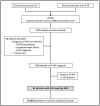Acute severe asthma requiring invasive mechanical ventilation in the era of modern resuscitation techniques: A 10-year bicentric retrospective study
- PMID: 33007018
- PMCID: PMC7531794
- DOI: 10.1371/journal.pone.0240063
Acute severe asthma requiring invasive mechanical ventilation in the era of modern resuscitation techniques: A 10-year bicentric retrospective study
Abstract
Purpose: Patients with acute severe asthma (ASA) may in rare cases require invasive mechanical ventilation (IMV). However, recent data on this issue are lacking.
Materials and methods: In this retrospective and bicentric study conducted on a 10 year period, we investigate the in-hospital mortality in patients with ASA requiring IMV. We compare this mortality to that of patients with other types of respiratory distress using a standardized mortality ratio (SMR) model.
Results: Eighty-one episodes of ASA requiring IMV were evaluated. Factors significantly associated with in-hospital mortality were cardiac arrest on day of admission, cardiac arrest as the reason for intubation, absence of decompensation risk factors, need for renal replacement therapy on day of admission, and intubation in pre-hospital setting. Non-survivors had higher SAPS II, SOFA, creatinine and lactate levels as well as lower blood pressure, pH, and HCO3 on day of admission. In-hospital mortality was 15% (n = 12). Compared to a reference population of 2,670 patients, the SMR relative to the SAPS II was very low at 0.48 (95% CI, 0.25-0.84). The only factor independently associated with in-hospital mortality was cardiac arrest on day of admission. In-hospital mortality was 69% in patients with cardiac arrest on day of admission and 4% in others (p < 0.01). Salvage therapies were given to 7 patients, sometimes in combination with each other: ECMO (n = 6), halogenated gas (n = 1) and anti-IL5 antibody (n = 1). Death occurred in only 2 of these 7 patients, both of whom had cardiac arrest on day of admission.
Conclusion: Nowadays, the mortality of patients with ASA requiring IMV is low. Death is due to multi-organ failure, with cardiac arrest on day of admission being the most important risk factor. In patients who did not have cardiac arrest on day of admission the mortality is even lower (4%) which allows an aggressive management.
Conflict of interest statement
The authors have declared that no competing interests exist.
Figures
References
-
- Global Initiative for Asthma. Global strategy for asthma management and prevention. 2019: https://ginasthma.org/wp-content/uploads/2019/04/GINA-2019-main-Pocket-G.... [Accessed 15 September 2020]
-
- World Health Organization. Asthma. 2019: https://www.who.int/news-room/q-a-detail/asthma. [Accessed 15 September 2020]


